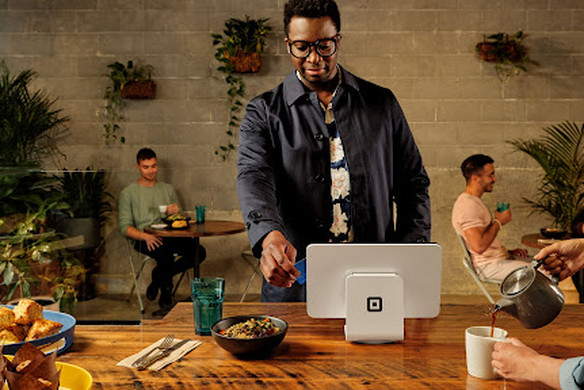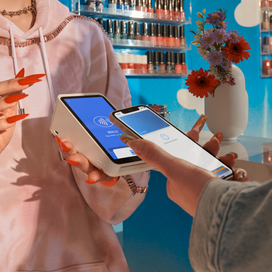Table of contents
What are mobile payments?
Mobile payments are regulated transactions that take place through your mobile device. That is, instead of paying for products or services with cash, checks, or physical credit cards, mobile wallets and mobile money transfers allow you to pay digitally. Since the growth of Apple Pay and other NFC payments isn’t slowing down, adapting to mobile payment technology is extremely valuable for your business.
Mobile payments can be used in a peer-to-peer context or to pay at a brick-and-mortar business. In a peer-to-peer mobile payment, you can make an electronic transfer via your bank, say, to pay back a friend for dinner or to pay someone on Craigslist for a piece of furniture. For mobile payments at a brick-and-mortar business, you can use an app on your mobile device — instead of cash or a card — to pay for specific goods or services at the checkout counter. In this instance the business needs a specific type of point-of-sale device to process the transaction.
What is a mobile wallet?
A mobile wallet is a digital wallet on your phone. In a mobile wallet app, you can add and store the bank details associated with your debit or credit card securely. Some mobile wallet apps allow you to add more than one card. So instead of using your physical card to make purchases, you can make a mobile payment with your device. If you want to accept mobile wallet payments at your business, you need to have a point-of-sale system that’s equipped with the technology that can process the transaction.
Mobile wallet technology
The technology that underpins mobile wallet payments is near field communication (NFC). This is what enables two devices, such as your phone and a payments reader to communicate wirelessly when they’re close together. Typically, a mobile device has to be within two inches from a reader to process the payment. NFC is a subset of radio-frequency identification (RFID), a technology that allows us to identify things through radio waves. RFID has been used for decades to scan items in grocery stores and luggage on baggage claims. Contactless payments have gained significant traction, and more businesses are beginning to accept this secure form of payment.
Mobile wallet adoption
From messaging to transportation apps to health monitoring, we’re using our phones more and more to take care of day-to-day life. So it’s no surprise that we’ve seen a proliferation of mobile payments apps in recent years. And a majority of Gen Z consumers (60%) prefer to use digital payment apps, compared to Gen X (54%) and baby boomers (44%).
Mobile wallet companies
There are a variety of companies that offer mobile payments apps. The most popular are Apple Pay and Google Pay. If you have a more recent model of an iOS or Android device, chances are that it can support a mobile payments app. On the merchant side of the equation, Square offers a payments processor and system that can accept mobile payments. All you need to start accepting Apple Pay and Google Pay at your business is the Square Reader for contactless and chip and your mobile device. Check here to see whether your device is compatible. Most new iOS and Android models are.
What are NFC mobile payments?
NFC, or contactless, payments are payments that occur in person between a mobile device and an equipped payments processor. To make a contactless payment, you need to have a mobile wallet app on your device or use a contactless-enabled credit or debit card. Learn how to check if your card is contactless enabled here. To accept an NFC mobile payment at your business, you need a payments reader, such as the Square Reader for contactless and chip. Contactless payments are as secure as EMV chip card payments but have some upsides when it comes to usage and speed.
Below are the most popular examples of NFC contactless payments and how to start paying with them. To learn more about NFC, read our in-depth guide, What Is NFC? Everything You Need to Know About Near Field Communication.
Apple Pay
Apple Pay works on the iPhone, version 6 or later, as well as the Apple Watch. To pay with Apple Pay, add any debit or credit card to the Wallet app on your device. When you’re at a store that accepts Apple Pay, hold your iOS device over the payments reader while holding your finger on the Touch ID button. If you are using a phone with Face ID or an Apple Watch, you can unlock the phone either with your face, a passcode, or, in both cases, a double-click on the side button to activate the unlock feature. This adds another layer of protection.
If you are a seller setting up Apple Pay, you will need a Square Reader enabled for NFC. Customers can also pay online through a checkout page using the Buy With Apple Pay button. If you run an online store, you can accept Apple Pay through your app or website without a reader. Read more about how to use Apple Pay and accept it at your business.
Google Pay
Google Pay is available on all NFC-enabled devices that run Android version 4.4 or later. To use Google Pay, open the app on your phone, and complete the transaction by holding your device over the payments reader. Google Pay requires you to have a secure lock screen.
Contactless cards
Some credit and debit cards are enabled with contactless NFC technology. To check whether your card is contactless-enabled, look for the wave-like logo printed on the front or back of your card. To pay, hold your card over the payments reader until you hear a beep.
How do mobile payments work?
Using mobile payments is simple and secure. To pay with your mobile device at a store’s checkout counter, hold your device close to the NFC-enabled payments terminal. The reader should be within two inches of the mobile phone to set the transaction in motion. What’s happening in a mobile wallet transaction is that your device and the NFC-enabled point of sale are essentially talking to each other. Using a specific radio frequency, they pass encrypted information back and forth to process the payment. This all takes just seconds. In fact, speed is one of the coolest parts of NFC payments. They take a fraction of the time of magstripe and chip card transactions and are leagues faster than cash.
There’s also something called tokenization at play in a mobile payment transaction. Tokenization is part of why mobile payments are so secure, as the technology safeguards your bank details in mobile payments apps. Let’s take Apple Pay as an example. Here’s how it works: After you take a picture of your credit card and load it into your iPhone, Apple sends the details to your card’s issuing bank or network. The banks and networks then replace your bank details with a series of randomly generated numbers, which is the token. That random number is sent back to Apple, which then programs it into your phone. This means that the account details on your phone can’t be cloned into anything valuable to fraudsters.
How can I accept mobile payments at my store?
To accept mobile payments at your store, you need to get a point-of-sale device that’s equipped with NFC technology, such as the Square Reader for contactless and chip.
Once you get your Square Reader, it’s easy to start accepting Apple Pay and Google Pay right away. All you do is ring up a purchase, look for the green light to appear on the Square Reader, and have the customer hold the phone over the device to pay. The whole transaction is completed in seconds. Learn more about how to get set up to accept mobile payments.
How to use Square Reader for mobile payments
- Purchase the Square Reader for contactless and chip.
- Download the Square Point of Sale app for iOS or Android.
- Ring up your customer in the Square app. When it’s time to pay, your customer can hold their mobile device within two inches of the Square Reader to complete the transaction.
- Receive your deposits as soon as the next business day. Square sends payments directly to your bank account in one to two business days.
Why use mobile payments?
On the peer-to-peer side of things, using mobile transfers allows you to forgo the hassle of cash and checks and get paid quicker. For in-store purchases, mobile payments are the best solution for a number of reasons.
They’re fast.
Mobile contactless payments are by far the fastest way to pay. Usually, they take about a second. They’re a bit faster than swipe payments, and much faster than EMV chip payments, which are sluggish. For businesses that have checkout lines, such as quick-service restaurants and retailers, contactless payments will become much more attractive as they can move the line faster, which means more sales in a shorter amount of time.
They’re convenient.
People carry cash less and less. People have their phones at the ready more and more. This combination makes mobile payments the most convenient way to pay. There’s no having to go to an ATM to pay someone back. You can do that by sending an electronic transfer through your bank’s app on your phone. And there’s no need to dig into your bag for your wallet at the checkout counter. You can just tap your phone to pay.
They’re secure.
Mobile payments have multiple layers of dynamic encryption, making them an extremely secure way to pay. They’re far more secure than magstripe payments and just as secure as EMV chip card payments. In fact, if you’re using a mobile payments app with Face ID, such as Apple Pay, it’s arguably more secure than an EMV chip card payment.
An added bonus for businesses? In a case study we conducted in Portland, Oregon, NFC payments increase tipping rates. Customers who used their phones or NFC devices to pay were more likely to tip than customers who used traditional magstripe cards. Here are a few other ways accepting mobile payments helps businesses.
The future of mobile payments is bright. Now is the time to future-proof your business.
The future of mobile payments
Mobile payments have revolutionized the way businesses are thinking about payments processing. On one front, we’re moving toward more secure, authenticated ways to process payments. And on another, we’re moving toward faster, more convenient ways to pay. Brands like Starbucks and CVS have created apps that allow you to save payment information and favorite products, so you can order your favorite coffee drink or refill your prescription with the tap of a button.
Mobile payments check both of these boxes and, therefore, are where everything is headed. To accept NFC mobile payments at your store, order the Square Reader for contactless and chip.
![]()











